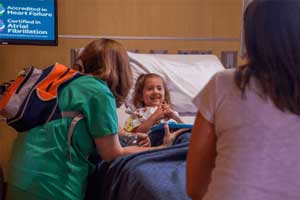- Home
- Editorial
- News
- Practice Guidelines
- Anesthesiology Guidelines
- Cancer Guidelines
- Cardiac Sciences Guidelines
- Critical Care Guidelines
- Dentistry Guidelines
- Dermatology Guidelines
- Diabetes and Endo Guidelines
- Diagnostics Guidelines
- ENT Guidelines
- Featured Practice Guidelines
- Gastroenterology Guidelines
- Geriatrics Guidelines
- Medicine Guidelines
- Nephrology Guidelines
- Neurosciences Guidelines
- Obs and Gynae Guidelines
- Ophthalmology Guidelines
- Orthopaedics Guidelines
- Paediatrics Guidelines
- Psychiatry Guidelines
- Pulmonology Guidelines
- Radiology Guidelines
- Surgery Guidelines
- Urology Guidelines
Pediatric care in the emergency department: Clinical Practice Guidelines

The American Academy of Pediatrics (AAP), American College of Emergency Physicians (ACEP) and Emergency Nurses Association (ENA) have released updated recommendations on pediatric readiness in the emergency department (ED).
This policy statement, published in the journal Pediatrics is intended to serve as a resource for clinical and administrative leadership in EDs as they strive to improve their readiness for children of all ages.
The utilization of a physician and nurse pediatric emergency care coordinator (PECC) is strongly connected with improved readiness.
Key Recommendations:
- The physician and nurse PECCs should promote acceptable skills, help develop quality improvement plans, review policies, and help facilitate the integration of pediatric needs in disaster preparedness plans.
- Competency evaluations for all ED clinical staff should include training in areas such as assessment and treatment, medication administration and delivery, airway management and vascular access procedures, device and equipment safety, resuscitation procedures, trauma management, and disaster drills.
- Age-specific policies, procedures, and protocols for emergency care of children should be implemented, such as the following:
- Disaster drills once every 2 years that include pediatric mass casualty considerations
- Availability of medications
- Abuse
- Children with special health care needs
- Physical or chemical restraint of patients
- Social and behavioral health issues
- Consent
- Sedation and analgesia
- Immunization management
- Triage
- Pediatric patient care should reflect an understanding of unique pediatric patient safety concerns, such as weighing children in kilograms and recording and reassessing a full set of vital signs.
- Processes for safe medication practices should be established, such as the following:
- Use precalculated dosing guidelines.
- Apply caution for all administered or prescribed medications and consider developing standardized order sets for high-risk medications (eg, opioids and antibiotics).
- An independent 2-provider cross-check process should be utilized for high-alert medications.
- Use a standard formulary for pediatric high-risk and commonly used medications.
- Reduce the size of available concentrations to the smallest number possible.
- The radiology department should have the equipment and skills to provide imaging studies of children and age- and size-specific practices to reduce radiation exposure.
- The laboratory should have the means to perform laboratory tests for children, which includes having available microtechnology for small or limited sample sizes.
- Pediatric equipment, supplies, and medications should be easily accessible, labeled, and organized (eg, kilogram weight, weight-based color coding).
"Recognition of the unique needs of children who are ill and/or injured and served by an emergency care facility, including children with special health care needs; the commitment to better meet those needs through the adoption of these recommendations; and an ongoing commitment to evaluate care quality and safety and maintain pediatric competencies should provide a strong foundation for pediatric emergency care," concluded the authors.
For further reference follow the link: https://doi.org/10.1542/peds.2018-2459

Disclaimer: This site is primarily intended for healthcare professionals. Any content/information on this website does not replace the advice of medical and/or health professionals and should not be construed as medical/diagnostic advice/endorsement or prescription. Use of this site is subject to our terms of use, privacy policy, advertisement policy. © 2020 Minerva Medical Treatment Pvt Ltd